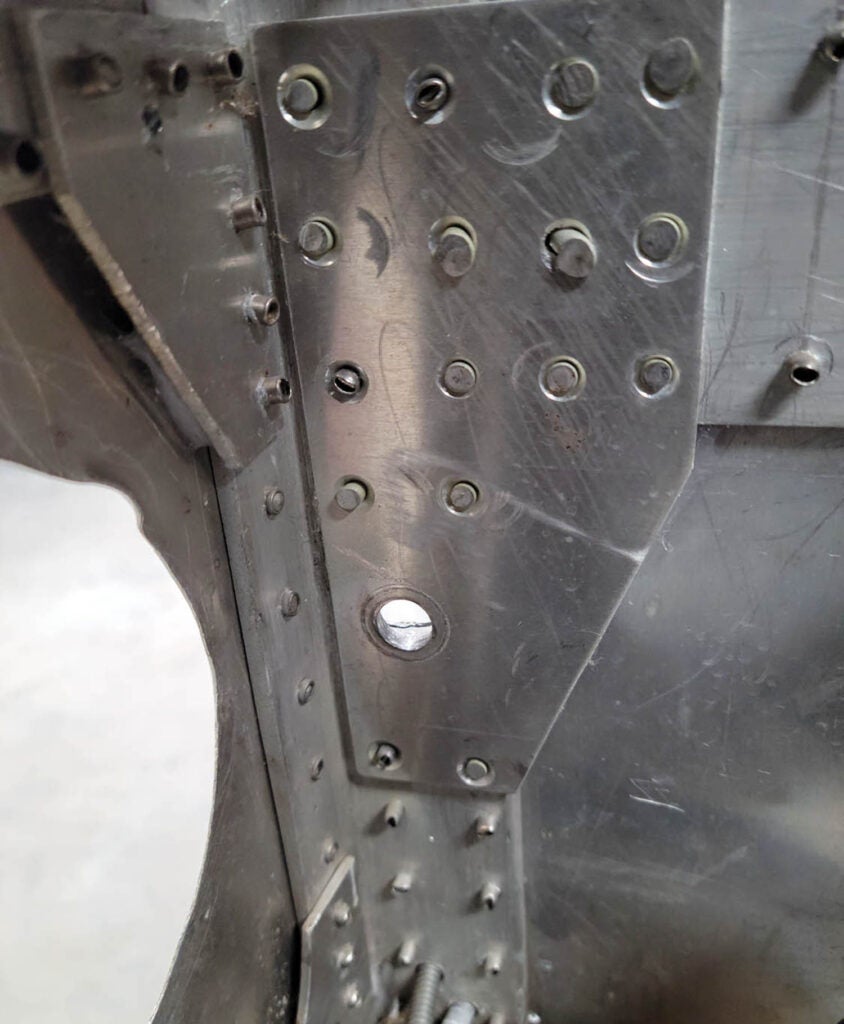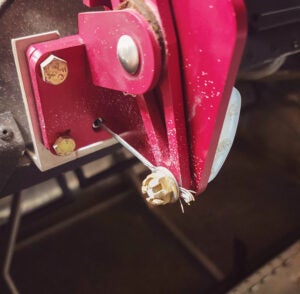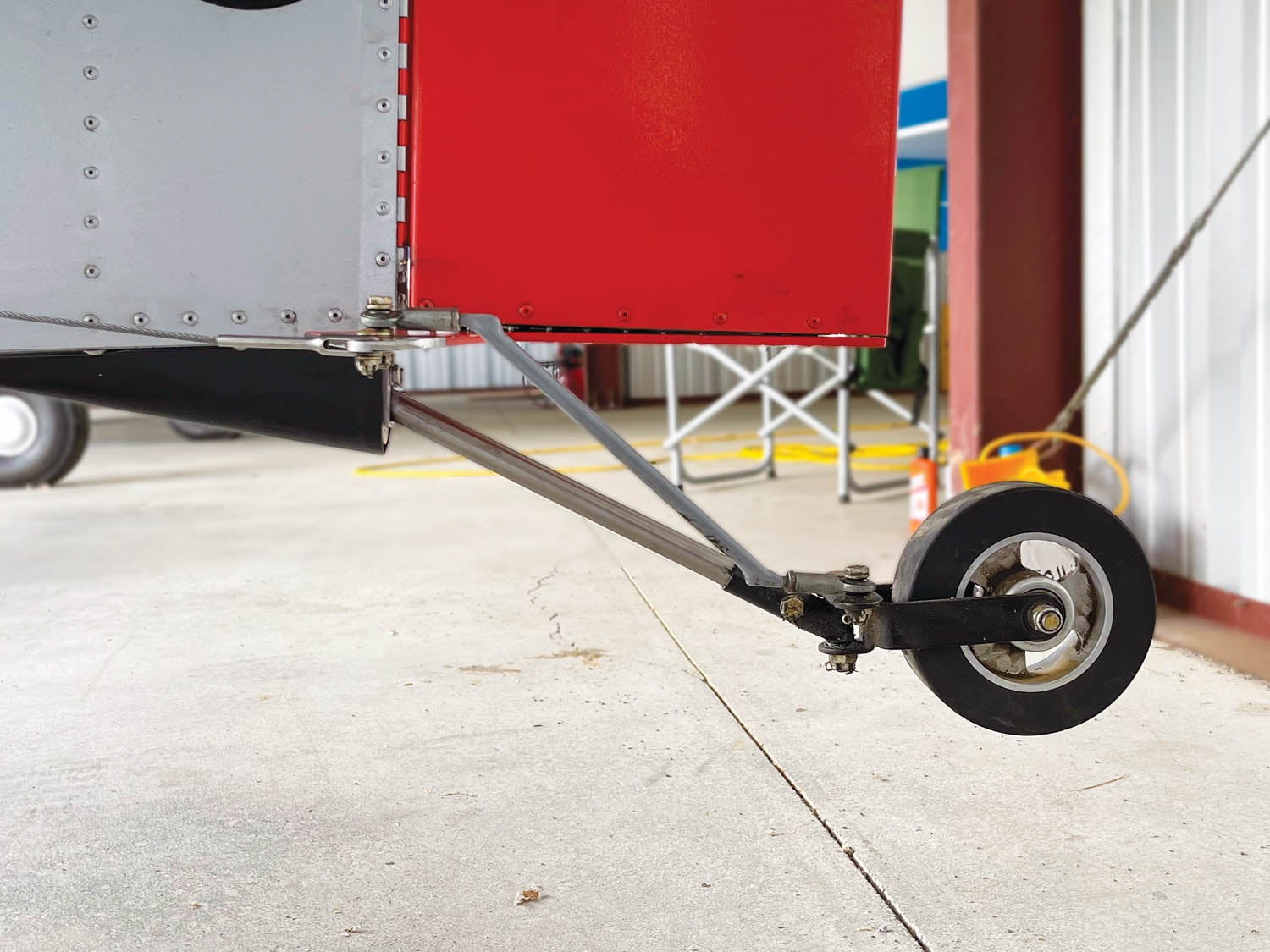
One Monday morning I opened an email from the second owner of a Onex. It was sent at 8:12 p.m. on Saturday. An attached photo showed a rudder drive rib separating from the rudder drive plate. (The rudder drive rib is simply the bottom rib in the rudder that is riveted to a flat-aluminum control horn.) If it had succeeded, rudder control would have been severed. My response to the customer was sent at 7:08 a.m. It included items to check and, as always, questions.
By 8:25 a.m. the customer responded with a link to a video he shared online the day before. The video recapped how he had a gut feeling he shouldn’t fly and how he found the failing assembly when he lifted the tail to clean the bottom of the fuselage. He notes that the airplane had a prebuy inspection, had passed a condition inspection two weeks prior and had had one previous condition inspection since he purchased it. Comments on the video were accumulating. Many praised the pilot (and rightfully so) for going with his gut feeling and not flying. Others said they were rushing to inspect their Sonex. Others were questioning the design. “Well, poop” (or words to that effect), I thought, “this is not going to be an easy day.”
I’d fought speculation before so I knew what to expect. By day’s end, my inbox, the video and the Sonex community would be abuzz with worried owners, builders, pilots and potential customers. There would be more speculating than California experienced in 1848. A proper investigation of the failure hadn’t even begun by those most qualified to perform one, the aircraft designers, yet suggestions for alternate designs were already being bandied about by people who didn’t know they were staring at a builder’s modification. To squelch the flames, I commented on the video, “We [Sonex] are in contact with [the owner] on this issue. Before knee-jerk reactions and wholesale panic sets in among the Sonex community, please read this…” I identified two plans deviations, one significant, which were visible in the video.

Inspection and Diagnosis
Sonex identified a modified tailwheel pushrod as a primary suspect in the failure. Whoever installed the non-conforming pushrod couldn’t have done a better job setting up the drive rib for failure. Essentially, they built a pry bar. The bottom of the rudder also appeared raised above where it should be on a properly built Onex. That changed the linkage’s geometry and further increased leverage on the drive horn. (The rudder hinge was also short one lug, though that would not have prevented this failure.)
Two days later, on Wednesday, the Onex’s owner reported, “The [tailwheel] drive rod seems to be the primary problem at this point…moving the rudder pedals to the rudder itself did very little to separate the horn from the rudder, however when the wheel was turned in one direction it caused severe pushing-down effect on the control horn. When I tried to resist it manually it was almost impossible. I’m thinking when it was still firmly attached any ground operations were probably causing a tremendous amount of force on that assembly.” He posted a follow-up video, but with a less dramatic title than the first: “So What Went Wrong? (Sonex Onex 090)” was the sequel to “I Almost Died—Sonex Onex.”
So What Did Go Wrong?
The drive horn failure was the result of a series of events that can strike any Experimental/Amateur-Built aircraft. It began with a builder’s deviation from a manufacturer’s parts and plans. The Experimental/Amateur-Built (E/A-B) category allows this, for better or worse. The current owner executed due diligence by having a prebuy
inspection, though we don’t know the inspector’s qualifications to inspect a tailwheel Onex. The initials “A&P” are not enough. The failure may not have been in progress at the time of that inspection, but the builder’s deviation was in plain sight. It could have been caught if the plans had been referenced during the inspection, or if the inspector was familiar with the design.
The most recent condition inspection also failed to discover the problem. But here’s the thing—even if the plans deviation had been noted by either inspector it is not within an inspector’s right to ground an E/A-B aircraft because something deviates from the plans. An inspector can point such things out and refuse to sign off an inspection, but they can’t force plans compliance.
There is nothing a kit manufacturer can do to ensure their parts and construction documentation are used. To think otherwise lacks any understanding of this hobby. They try, however. Van’s Aircraft issued Service Letter SL-00062 (a must-read for every E/A-B owner), which states, in part, “Any changes, enhancements, or modifications made by the builder, owner, or any other person are made at that person(s) own risk, and the person making the changes as well as anyone who operates that aircraft anytime in the future, bears the responsibility for evaluating, understanding, and accepting any consequences of such deviations from the plans.”
The owner of the aircraft found the defect, through pure luck, when he lifted the tail to clean the bottom of the fuselage. After so many inspections by, we assume, professionals, his discovery fell right where the FAA places ultimate responsibility for the airworthiness of an aircraft: 14 CFR section 91.403(a) of FAR Part 91, subpart E, states, “The owner or operator of an aircraft is primarily responsible for maintaining that aircraft in an airworthy condition, including compliance with FAR Part 39 of this chapter.” This regulation applies to all GA aircraft and I’d argue it particularly applies to owners of E/A-B aircraft, of which no two are the same.

Doing It Better
Used homebuilts can have and hide modifications known only to the builder. Those modifications have the power to kill. Here are some inspection tips that may save your life.
First, know what you own. Too often, owners of used aircraft I speak with have no idea what they own. Once, a customer couldn’t communicate his issue to me clearly because, it turned out, he didn’t know which model Sonex he purchased.
Get a prepurchase inspection by someone who built the same model aircraft and can identify deviations from the plans. They don’t have to be an A&P; you aren’t seeking a logbook sign-off.
Inspect the airplane with assembly documentation in hand. Inspecting an unfamiliar aircraft without the kit manufacturer’s documentation is like flying an unfamiliar airplane without a checklist.
When you get your airplane home, invest every minute it takes to inspect it inch by inch. This must be done with the designer’s construction documentation in hand.
When you need a condition inspection, find an A&P familiar with the design. If that isn’t possible, find one who is a homebuilder and understands the E/A-B category. If they don’t insist on having the plans in hand when they inspect the airplane, you must insist they do.
The presence of any deviation must trigger a closer look at the impacted components and systems. Once that is done, remedy the deviation.
A kit company can react to failures of their parts or design by issuing a service bulletin. There is nothing they can do about builder modifications. The success or failure of a modification, as Van’s Aircraft points out, is on the builder’s shoulders and the shoulders of all future owners. As I approach the last period of this column, over 40 days have passed since that Onex’s drive rib failure. No other owners have reported a similar issue. The aircraft’s owner has repaired the rudder with proper parts. Online speculation continues on the cause, with some comments beginning “I’m an A&P…” Remember, that aircraft had already been inspected, at least twice, by A&Ps.
Disclosure: Kerry Fores is Sonex’s Technical Support Manager.














I was disappointed that the article ‘A Cautionary Tail,’ didn’t focus more on the really poor workmanship seen in the photograph. Those solid rivets were terrible. If that assembly passed the inspections noted in the article, either; the homebuilt workmanship standards leave a lot to be desired or, the inspectors really suck (IMHO).
M. Levenberg
Hi Michael,
Thank you for reading and commenting. I didn’t focus on the multitude of sins in the photo with the rivets because riveting wasn’t the focus of the column and I have a word limit for my columns. I can expand here, however. In addition to the solid rivets being poorly set, if built to the plans there shouldn’t be ANY solid rivets anywhere in that photo and the shop end of each rivet in the gusset plate should be visible, as they are in the angle below the gusset. Also, none of those visible holes should be countersunk.
The current owner (not the builder) is correcting a host of builder errors and assured me that airplane was signed off and flying.
~Kerry
What blows me away is that the proper assembly uses pulled rivets, and you have to try awfully hard to screw up as bad as the rivets in that bracket. So glad the new owner caught thee issues and fixed them.
It would have been easier and faster to do it properly, than the disaster that bracket became.
Good stuff, Kerry. I actually just watched the Onex owner’s entire series on that his airplane and that failure. It’s a good example of why we should be extra cautious of an E/A-B with a laundry list of extra mods. Just like in the certified world where one STC may be by itself okay, piling on the mods can introduce variables none of the original or STC designers could have accounted for. Thanks for the insights from your side of this YouTube saga!
Hi Gregory,
Thank you for reading and commenting. The E/A-B category should not be approached casually, though its very designation Experimental- Amateur Built infers a cavalier attitude is acceptable.
~Kerry
As a EAA Tech advisor, I wouldn’t call that shoddy workmanship, I would call it total crap..how any one would perform that kind of work and think is would be ok is beyond me. Surprised they didn’t ask for the help .
Agreed, that mess of a bracket took far more work to get wrong, than it would have taken to get it right. People never cease to amaze me sometimes.
Hi Chris,
Thank you for reading and commenting. The disturbing truth is many people don’t know they are doing a poor job and others resist help as a matter of pride. I often push people toward finding help, but the help can often be a problem as well. I cant recall the number of times a professional–i.e., someone who makes money working on engines, or a machine shop, or an A&P) have produced substandard workmanship that a builder has complete confidence in because they paid cash money for the work.
Very good comments, and I agree with the responsibility of owners and pilots of E/AB craft. It would be interesting to se a picture of Onex factory pushrod beside the suspected defective designed one, just for reference sake.. Always good stuff! Thanks!
If you watch the linked videos, and his following videos, he shows the repair and does an excellent side by side comparison.
Ditto to all of the above. The worst rivets I drove getting my A&P were orders of magnitude better than the worst rivets on the rudder plate. If my rivets were as bad as these, I would have flunked myself!
Many years ago, a technical counselor at an EAA Chapter meeting said the best way to inspect an EA-B when you don’t have unlimited time is to look at the workmanship in areas that aren’t normally visible, such as safety wiring. If he did a good job where no one can see, he probably did a good job everywhere. It doesn’t look like anyone looked at that area of the plane, as it was probably difficult to get to. I hope the current owner went through the plane with a fine-tooth comb because the overall workmanship stinks!
Hi Richard,
Thank you for reading and commenting. Inspecting the hidden areas of a homebuilt is a great technique for judging both workmanship and maintenance. If the corners of the fuselage are filled with accumulated grime you can bet the entire aircraft has recieved as little maintenance as possible.
To clear one item up, the photo with the poor rivets is not associated with the failed Onex rudder. That plate is a wing spar tunnel support gusset on a Sonex. The large hole is where a main spar pin passes through to secure the wing in the fuselage. Different airplane, different builder, but equally serious possible consequences. Thankfully the current owner is making right all the wrongs hidden in that airframe and knew what they were buying before they bough it.